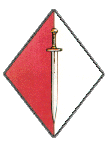
The Calling of Saint Geldara

 |
The Calling of Saint Geldara |
 |
As fortune would have it, however, during that brief stay in its final home, the tapestry caught the eye of the young Yebael Cassean, who was briefly staying at the manor with her aunt. Yebael was determined to make a copy of the tapestry for herself, and prolonged her stay there considerably to work on the project. Having done all that she had to with the original to work from, she and her aunt then moved on, and the tapestry was left incomplete for the rest of the journey.
Several months after returning home to Harchesa Abbey, Yebael received word of the disaster that had befallen the original tapestry. She determined to finish the work that she had started, and spent the winter of 1286 doing so. From that time on the tapestry has hung in whatever quarters Yebael has lived in, including the room she and Syman now occupy at Menekod.
Some days later, while she was out playing in the meadows with her sisters, she saw a red butterfly, just like in her dream, fluttering nearby. Leaving her sisters she ran after the tiny creature, trying to catch it in her small hands. Always, however, it evaded her grasp, and continued to fly away, towards the sun. Geldara, now far away from her sisters, continued in pursuit. She did not grow tired, and ran until her village was far behind. And though in her home it grew dark, she followed the butterfly, and the sun, with such eagerness that it was still only afternoon, and at length she reached the place where the sun shines always.
Back at Nema, her two sisters ran back to Misa, telling her in sobbing voices of Geldara's flight. Misa went straight to the lord of the manor, and asked that he ride out to fetch her daughter. The lord was about to refuse, but his young son said that he would find the girl, and immediately set out on his horse. There was no moon, and he rode slowly in the darkness for many hours. And though the time came for dawn, the sun did not rise; but in its place the moon, a pale thin crescent, appeared above the horizon. Still the young man rode, and when the moon set behind him, he had still not found the girl.
Once again the sun did not rise when it should, and without any light to guide him, he travelled slowly. With the next moonrise, he galloped on, the larger crescent giving him more light than the previous night. So he rode, with barely a pause, for many lightless days, while the waxing moon showed him the path at night. At last, after driving his horse to exhaustion beneath the full moon, he was greeted with his first dawn in many days. And as the first rays shone forth over the horizon, they revealed Geldara sitting in rapture in a small hollow in the ground.
When he saw her, the lord's son fell deeply in love with the weaver's daughter, and he asked her to accompany him back to the village where they might be wedded. She refused to go with him, however, for the Goddess had summoned her to do Her bidding, and that she must do. She had been charged with taking Larani's light to those places still in darkness. The young man begged to be allowed to accompany her, but again she refused, saying that the Goddess had asked this of her and her alone. Dejected, he returned to the village without her, and gave the news of Geldara's fate to her family. Though they mourned that they would not see her again, her mother and sisters rejoiced that she had been so blessed by the Lady. But the young man could not be consoled by their happiness, until the eldest sister gave him the tapestry Geldara had made not long before. Then the man's heart was gladdened, and he saw that this was truly the Goddess' will.
In the centre a girl in the long robes of a priestess is running after a red silk butterfly which is rimmed in white. Her arms are outstretched, and her fingers curl in an attempt to grasp the elusive insect. The girl is running up the gentle slope of a green hill, beyond which the sun is setting (done in white and yellow). Behind her, in the bottom left corner of the piece, a few houses stand.
What few incidental details there are are kept well to the background: a few faces can be seen looking out from the houses, while one figure stands in the shadow of a doorway; scattered clouds range in the left portion of the tapestry, and a few little bushes, plants and flowers dot the hillside. Beyond the peak of the hill, and below the sun, the land is shown as sloping down quite steeply, probably to clearly emphasise the summit in the small space between the peak and the right edge of the tapestry.
Original author was
Jamie Norrish,
but has been edited by Avathar Valcana
for campaign reasons.